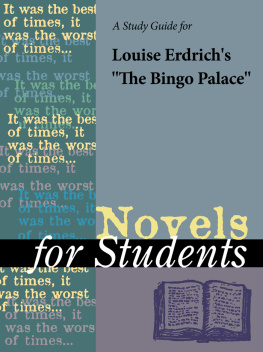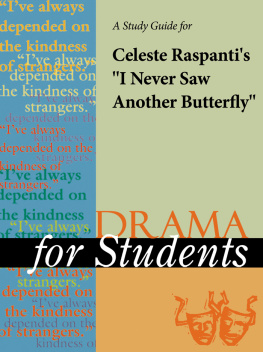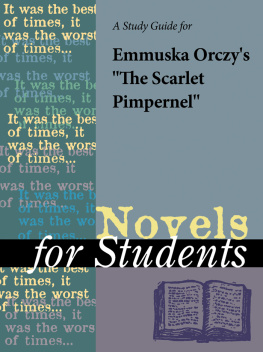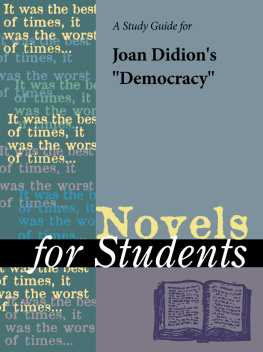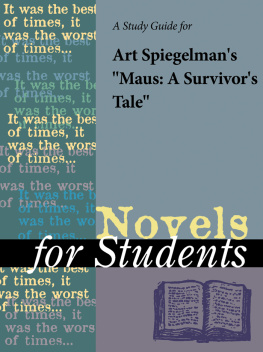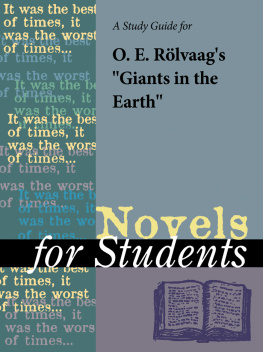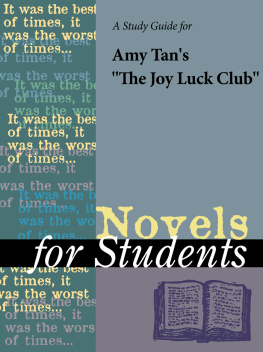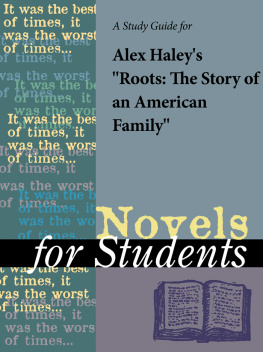TABLE OF CONTENTS
Guide
Novels for Students, Volume 40
Project Editor: Sara Constantakis
Rights Acquisition and Management: Leitha Etheridge-Sims, Tracie Richardson
Composition: Evi Abou-El-Seoud
Manufacturing: Rhonda Dover
Imaging: John Watkins
Product Design: Pamela A. E. Galbreath, Jennifer Wahi
Content Conversion: Katrina Coach
Product Manager: Meggin Condino
2012 Gale, Cengage Learning
ALL RIGHTS RESERVED. No part of this work covered by the copyright herein may be reproduced, transmitted, stored, or used in any form or by any means graphic, electronic, or mechanical, including but not limited to photocopying, recording, scanning, digitizing, taping, Web distribution, information networks, or information storage and retrieval systems, except as permitted under Section 107 or 108 of the 1976 United States Copyright Act, without the prior written permission of the publisher.
Since this page cannot legibly accommodate all copyright notices, the acknowledgments constitute an extension of the copyright notice.
For product information and technology assistance, contact us at Gale Customer Support, 1-800-877-4253.
For permission to use material from this text or product, submit all requests online at www.cengage.com/permissions.
Further permissions questions can be emailed to permissionrequest@cengage.com
While every effort has been made to ensure the reliability of the information presented in this publication, Gale, a part of Cengage Learning, does not guarantee the accuracy of the data contained herein. Gale accepts no payment for listing; and inclusion in the publication of any organization, agency, institution, publication, service, or individual does not imply endorsement of the editors or publisher. Errors brought to the attention of the publisher and verified to the satisfaction of the publisher will be corrected in future editions.
Gale
27500 Drake Rd.
Farmington Hills, MI, 48331-3535
ISBN-13: 978-1-4144-8538-6
ISBN-10: 1-4144-8538-7
ISSN 1094-3552
This title is also available as an e-book.
ISBN-13: 978-1-4144-8231-6
ISBN-10: 1-4144-8231-0
Contact your Gale, a part of Cengage Learning sales representative for ordering information.
Printed in Mexico
1 2 3 4 5 6 7 16 15 14 13 12
The Bingo Palace
Louise Erdrich
1994
Introduction
Louise Erdrich's The Bingo Palace tells a realistic story about the growth of casinos and gambling on American Indian reservations. But Erdrich also explodes that world into a fantastic landscape of magical realism to provide a post-modern exploration of the place of the American Indian in the contemporary world. Almost all of Erdrich's body of work collectively forms a single coherent narrative about the people living on a North Dakota Indian reservation, and everyone and everything connected to them. Her self-avowed concern in her fiction is to explore the world of her childhood and her ancestors, such that her oeuvre is a version, a translation into narrative, of her family history.
The Bingo Palace (1994) is set at the time it was written, in the early 1990s, and details episodes in the lives of characters Erdrich has chronicled in other writings throughout the twentieth century, as well as their children, grandchildren, and great-grandchildren. In some respects, Erdrich's works superficially resemble a soap opera, with innumerable threads of plot about different characters occasionally coming together and spinning apart, but this is because she is describing the life of a community rather than that of an individual. Readers should be aware that the novel includes a detailed, though nongraphic, description of a rape, making the book less suitable for younger teenagers.
Author Biography
Erdrich was born on June 7, 1954, in Little Falls, Minnesota. Her father, Ralph, was of German descent, while her mother, Rita, was of mixed heritage, her father being the tribal chairman of the Turtle Mountain Band of Chippewas. They both worked as schoolteachers for the Bureau of Indian Affairs, mostly in Wahpeton, South Dakota. From 1972 to 1976, Erdrich attended Dartmouth College, where she earned a BA; in 1979 she received a master of fine arts degree in creative writing from Johns Hopkins University. She put herself through school by working odd jobs.
Erdrich met her future husband, Michael Dorris, at Dartmouth, where he was a professor of Native American studies. They would eventually have three children together, also raising three children whom Dorris had adopted as a single father. Dorris contributed important research to the problem of preventing fetal alcohol syndrome (which afflicted all three of his adopted children) among children born on reservations.
As Erdrich had more and more success publishing poems and short stories, she and Dorris collaborated on a number of projects, including the novel The Crown of Columbus (1991). Dorris may also have contributed to some of the early novels published under Erdrich's name. Dorris eventually involved the couple in scandal when it became clear that he was not, as he claimed, an Indian, and because of accusations by two of their adopted children that Dorris had abused them. Their son Reynold was run down by a car and killed in 1991. In the midst of all this, Erdrich published The Bingo Palace in 1994, firmly establishing her literary independence from Dorris. By 1995 the couple had divorced, and on April 10, 1997, Dorris killed himself.
Since then, Erdrich has done everything she can to keep the details of her life private (she does not, for example, maintain her own Web site, except in connection with her bookstore in Minneapolis). But it is known that she has had another child with Tobasonakwut Peter Kinew, an Ojibwe medicine man who also works as a professor, lecturer, and adviser to several Ojibwe bands. Erdrich has published widely, including more novels and short stories set on the Turtle Mountain Reservation (or featuring characters connected to the reservation), among them The Beet Queen (1986) and The Master Butchers' Singing Club (2003), as well as unconnected novels, such as Shadow Tag (2010). She has also written a number of books for children and young adults, including Grandmother's Pigeons (1996).
Plot Summary
Chapter One: The Message
The message is a wanted poster. Lulu Lamartine sends a copy of a wanted poster for her son Gerry Nanapush to her grandson Lipsha Morrissey, to suggest he ought to stop wasting his life drifting between menial jobs and the drug culture. Gerry has just been captured, so she rips the poster down from the post-office wall and frames the original in her apartment. Lipsha does come back.
Chapter Two: Lipsha Morrissey
When Lipsha reaches the reservation one evening, a powwow is in process, with many people dancing in traditional dress in the high-school gym. Among these is Shawnee Ray Toose, still a high-school senior, with whom Lipsha, who is about ten years older, instantly falls in love. Lyman Lamartine, the putative father of Shawnee Ray's son Redford and the official in charge of business on the reservation, is also at the powwow. Although he came back to change his life in response to his grandmother's message, once he arrives, Lipsha feels like the helpless plaything of his manipulative aunt, Zelda Kashpaw (with whom Shawnee Ray lives).

